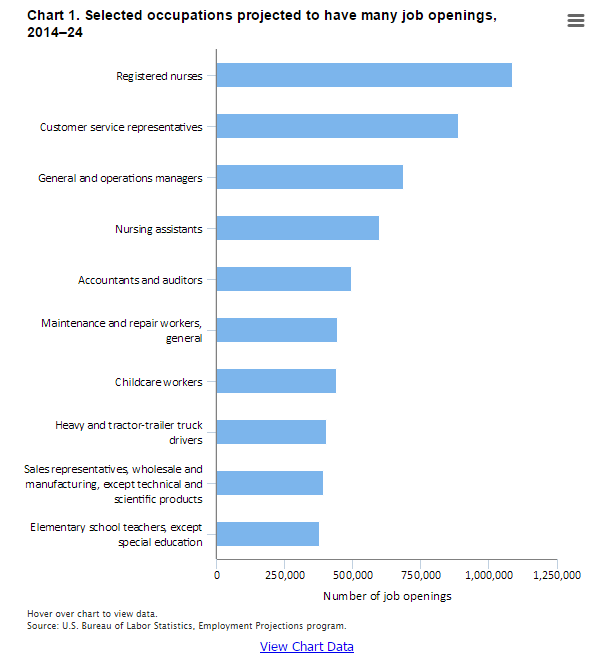Original article by Elka Torpey
Do you ever wonder if the grass is greener in another field? If you’ve resolved to find out, the new year might be a good time to pursue a new career.
There are many reasons to change careers. Maybe your interests have shifted, or you want the potential for earning more money. Or perhaps you just want to try something new.
Whatever your reason, it may be helpful to look at U.S. Bureau of Labor Statistics (BLS) data and to consider what experts say about changing your line of work.
Tip 1: Figure Out Your “Why”
In deciding to change careers, it’s a good idea to consider what’s driving your desire. “Are you unhappy with your employer? Do you want to use different skill sets? What is it that needs to change?” says career management coach Marie Zimenoff. You need to ask yourself these kinds of questions to know the type of change you should make.
Think about your most recent job. What parts of it didn’t you like? Perhaps more importantly, what parts did you like? Are you sure you want a different occupation—or should you just look for a new job?
Make a list of the tasks you enjoy most. For example, maybe you’re a biological technician, and you really like working with people. Some occupations might allow you to use your people skills while still applying your scientific knowledge. Would you like to be a biology teacher? Work toward a management position at your current company? Become a scientific product sales representative?
This type of reflection can help you identify occupations you may want to enter, or it might help you decide to stick with your current occupation and instead work in a different setting or job. “People often think it will take a huge change to make them happy,” says Zimenoff. “You might want to start smaller with a change that doesn’t uproot your whole life but will make you happier in your next career.”
Tip 2: Look at the Data
If you’re thinking of changing occupations, you aren’t alone. According to 2015 and 2016 data from the Current Population Survey, about 6.2 million workers (4 percent of the total workforce) transferred from one occupational group to another. These and other BLS data can offer guidance as you explore your options.
Projections data. Career changers are likely to be interested in occupations that offer opportunity, and BLS data can help you identify those. For example, chart 1 shows selected occupations projected to have many job openings between 2014 and 2024.

Economists in the BLS projections program also analyze occupations to determine education and training typically required for entry. With these determinations, you can see whether you qualify for a particular occupation—or, if not, what preparation you may need
State labor market offices use BLS national data to create their own projections. Some states also have detailed, current information available by region.
Other data. Employment, wage, and transfer data may also point you toward career choices. For example, employment and wage data show how many jobs were in a particular occupation and how much money workers made. In 2015, there were about 138 million wage and salary jobs overall, with a median annual wage of $36,200.
BLS data also shed light on worker mobility. You can click on the bars in chart 2 to see some of the occupation groups to which workers transferred. For example, clicking on architecture and engineering shows that the largest percentage of workers in this group moved to legal, construction and extraction, and sales and related occupations.

Tip 3: Connect with Others
Reaching out to others, both to learn about your options and to help you find a job, is important for all jobseekers. But it’s even more crucial for people who want to switch to a new field. “When you’re changing careers, you may not look great on paper,” says Zimenoff, “and the bigger the change you’re making, the more true that will be.”
Networking. Developing contacts, say experts, is essential—and it’s easier than most people realize. Experts say that networking works best when you start with the people already in your circle and ask specific questions. For example, you might ask your family or friends what they think about a certain company, or if they know anyone who works there. “It’s not as scary if you start with the people you know best,” says Zimenoff.
Visit networking sites to find out how the people you know are connected. But make an effort personally, too, such as with a phone call. For example, you might call your uncle and ask, “How well do you know this person? Might she be a good contact for me?”
Informational interviews. After you’ve identified people in an occupation that interests you, talk to them about their work. “Have a ready list of questions,” says master career specialist Elizabeth Craig, “such as, ‘What did you like most about your work today?’ ”
Do your research ahead of time and assure the people you talk to that you’re only looking to gain information—not asking for a job. Be sure to send a thank-you note afterward and try to stay in touch, keeping them informed of your progress. You might also ask for advice on how to make your résumé stand out when you’re ready to start applying for jobs.
Internal contacts. Knowing people who work somewhere you’d like to work is helpful, experts say. Not only do internal contacts give you an insider’s perspective, but they also might increase your chances of being a “referred candidate”—someone suggested for an interview by a worker within the company—when you apply for a job. Internal contacts also can let you know about job openings as soon as, or sometimes before, vacancies are advertised.
Tip 4: Match Your Skills
As you start applying to jobs in a new field, you’ll need to highlight the skills you have that match what each job requires. Using a chronological résumé, which summarizes work history, is a good way to describe specific accomplishments.
Fit skills to jobs. It’s especially important when changing careers to tailor each résumé and cover letter to the specific position for which you are applying. Focus on skills you have that are directly relevant to the job tasks, say experts, not the fact that you’re transitioning.
On paper and in person, you should be able to translate how your skills and experience match the position you’re applying for. “Look at the work you’ve done before, piece by piece,” says Craig. “Look at each segment and ask, ‘How would that relate to the new work?’ ” Use the requirements from the job posting as a guide, or study online profiles of people currently in the job to see how they describe their qualifications.
Switching careers may be easier between some types of occupations than others. This is particularly true when the occupations have skills in common, but it’s still up to you to make that connection. “Those who get interviews are able to show that they’ve done the things the job requires, in a particular context, and that it provided value to the company when they did it,” says Zimenoff.
Be proactive. You may have a skills or knowledge gap to overcome, depending on how different your new job is from the one you’re leaving. That’s OK. But you should be realistic about what you need to do so you meet employers’ expectations.
If you’re not qualified for your dream career, start working toward it. Do you need more work experience? Additional skills? Professional certification? “There are many opportunities for people to get up to date in a new field, often in a relatively short amount of time,” says Craig, and that doesn’t always mean earning a degree.
Even if you do need additional training, though, assessing your existing qualifications can help you figure out exactly what else you need. “The beauty of looking at the skills you have,” says, Zimenoff, “is that you can build on them instead of starting over.”
Tip 5: Get More Information
Resources from BLS can help you decide what type of work you want to do and what type of skills you need to do it. For example, the Occupational Outlook Handbook (OOH) provides information about nearly 600 occupations in 329 profiles that describe job tasks, wages, outlook, and more.
Career Outlook articles that may be helpful for brushing up on your jobseeking skills, include








